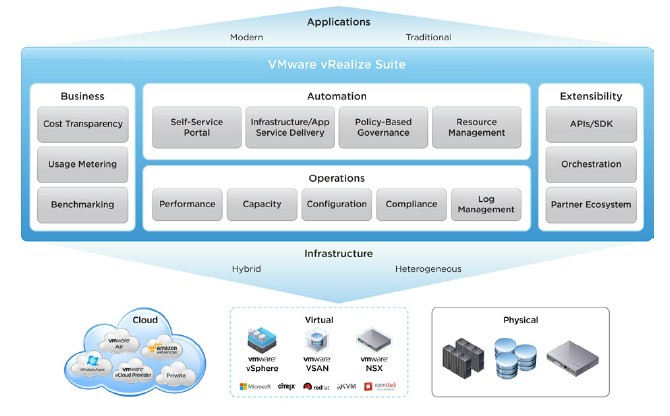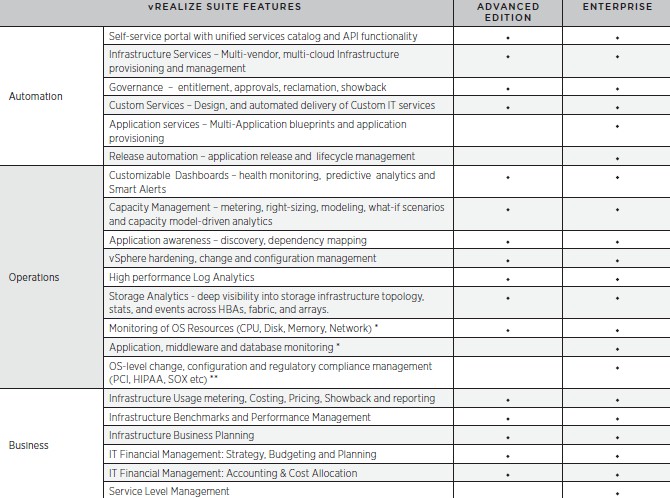VMware Pushes Cloud Scale Up To 100K VMs With vRealize

As part of a rebranding campaign that started back at VMworld a month and a half ago, server virtualization juggernaut VMware changed the brands on its various cloud management tools, a mix and match of software it had created internally or acquired in the past several years. Now, VMware has broken the pieces of those tools apart and put them back together in a modular fashion that allows customers to buy cloud management functionality in smaller pieces either on premises or as a service running in the cloud.
The new cloud management stack is called vRealize, and Sajai Krishnan, vice president of marketing for the cloud management business unit at VMware, tells EnterpriseTech that somewhere around 75 to 80 percent of the code in the vRealize stack is brand new, a massive undertaking that was necessary to extend its functionality beyond VMware's own hypervisors into other clouds and to break it up into smaller chunks.
"Customers are looking for alternatives to buying big bang suites," Krishnan says. They want to have the option of getting all of the bells and whistles that a full suite of tools offers, but they want to be able to buy it piecemeal as their needs dictate and not have to buy everything all at once.
The new vRealize stack includes over 15 modules and includes three core components that VMware had been selling and that have been substantially revamped: Operations, Automation, and Business. The suite also includes the Log Insight log analysis tool, since log files are an increasingly important part of the data analytics landscape and, importantly, are not only used to figure out what end users are doing on applications but how the hardware and software components of a platform are themselves operating. Generally speaking, the vRealize suite is used to manage heterogeneous platforms in the datacenter and extends out to public clouds. The software not only manages VMware's ESXi virtualization platform, but also hooks into physical servers as well as those that are virtualized using Microsoft's Hyper-V or the open source KVM hypervisor. It can also reach into and control capacity and applications on AWS and OpenStack clouds. vRealize does performance monitoring and predictive analytics for capacity planning, optimizes capacity, and costs out and meters the capacity and services in an application stack.
vRealize Operations is based on what was formerly known as vCenter Operations Management Suite, a set of tools that VMware got through its $100 million acquisition of Integrien back in the summer of 2010. About 80 percent of the vCenter Operations code has been rewritten to create vRealize Operations 6.0. The first big change is that the tool includes a lot of analytics and self-learning features so system administrators do not have to cope with tens of thousands of alerts rolling across their screens having to do with their virtual server clusters. The new vRealize Operations is a lot more scalable than vCenter Operations, too. The latter topped out at about 12,000 virtual machines, while the former can now scale to somewhere between 80,000 and 100,000 virtual machines, according to Krishnan. The new version has no single master controller, but a set of federated controllers that do their work in a round-robin, fully distributed fashion. The prior tool used a master/slave architecture, and a big chunk of the work to transform vCenter Operations into vRealize Operations was to change the method in which the tool scaled, says Krishnan, who said this work was, "non-trivial."
The vRealize Automation 6.2 module of the cloud management suite, which comes from the DynamicOps acquisition from July 2012 and which had a substantial rewrite last fall, has been tweaked as it goes into the new suite. The big change is that the alerts in vRealize Operations can be linked to vRealize Automation so that alerts can automatically kick off policy-governed actions when certain conditions are met. And, the Automation module can reach into VMware's NSX virtual networking stack and provision and manage virtual networks, and importantly, deploys network services through templates so that when applications are removed from the system the security policies and firewall rules go with them and network admins do not have to go erase these things manually from their networks. This module of the suite also has better means of figuring out what resources on public and private clouds are idle and can be used to reclaim those resources for other work or shut them down.
vRealize Log Insight 2.5 is also included in the vRealize suite, and it also integrates with the Operations module and has its own role-based access controls. VMware has also made Log Insight available in more languages, including German, French, Japanese, Korean, and simple and traditional Chinese. The vRealize Business 6.0 module, formerly known as IT Business Management and coming through its acquisition in June 2011 of Digital Fuel, is used to compare the capabilities and costs across internal and cloudy infrastructure. With the latest release of this module, the company's own VMware Air public cloud is added to the mix. The company is also beta testing benchmarks for clouds, which feed into the performance management and pricing elements of vRealize Business; those pricing tools no longer have to hook into the company cost modeling and general ledgers to work.
In addition to updating these four modules, VMware has created a new module, called vRealize Code Stream, which is the company's first foray into the DevOps movement. Code Stream 1.0 will hook into source control tools such as Jenkins, Bamboo, Git, and Subversion and will allow programmers to pick the integrated development environment (IDE) of their choosing to write and debug code in a continuous, iterative fashion as is done among hyperscale companies these days. Code Stream will hook into the vRealize Automation tool to move code from development through test and out to production environments.
VMware is also unveiling a beta of a tool called vRealize Air Compliance, the second SaaS management tool to come out of the company. (The first was vRealize Air Automation, which debuted as a beta at VMworld back in late August.) vRealize Air Compliance does just what the name suggests: it looks at the virtual infrastructure deployed on the VMware Air cloud and sees if it is in compliance with coding and data access rules for the company, and does this in a continuous fashion with event-driven, real-time change detection. VMware Air Automation, which is the SaaS version of the in-house Automation module in the vRealize suite, will probably be in beta until February or March 2015, says Krishnan; more than a hundred customers are testing it now.
The updates to the vRealize suite and the new Code Stream module are expected to ship sometime in the fourth quarter. vRealize comes in two editions, Advanced and Enterprise, as the table above shows with their respective features. vRealize components will be available for on-premises licensing on a per processor socket basis and on a per operating system instance (OSI) for physical hardware or for instances running on public clouds. For now, VMware is only providing on-premises pricing for vRealize, which is $6,750 per socket for Advanced and $9,950 per socket for Enterprise. vRealize Code Stream will be priced separately from the bundle, at $1,250 per OSI or $7,500 per socket.












